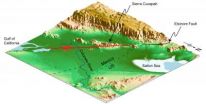(Press-News.org) (Santa Barbara, Calif.) –– Viruses fill the ocean and have a significant effect on ocean biology, specifically marine microbiology, according to a professor of biology at UC Santa Barbara and his collaborators.
Craig A. Carlson, professor with UCSB's Department of Ecology, Evolution, and Marine Biology, is the senior author of a study of marine viruses published this week by the International Society for Microbial Ecology Journal, of the Nature Publishing Group.
The new findings, resulting from a decade of research, reveal striking recurring patterns of marine virioplankton dynamics in the open sea, which have implications regarding our understanding of cycling of nutrients in the world's oceans.
Marine viruses encompass enormous genetic diversity, affect biogeochemical cycling of elements, and partially control aspects of microbial production and diversity, according to the scientists. Despite their importance in the ocean, there has been a surprising lack of data describing virioplankton distributions over time and depth in open oceanic systems.
"Microbial interactions, between oceanic viruses and bacteria, take place on the nanometer scale but are extremely important in governing the flow of energy and the cycling of nutrients like carbon, nitrogen, and phosphorus on the ecosystem scale of the world's oceans," said Carlson. The scientists studied microbes in the water column of the Saragasso Sea, off of Bermuda, for a decade.
"Although we can't see them with our naked eye, marine microbes are the dominant life forms in our oceans," said Rachel J. Parsons, first author and a microbial oceanographer with the Bermuda Institute of Ocean Science. "They comprise 95 percent of the living biomass in the oceans –– more than all the krill, fish and whales put together. They grow at rates many times faster than larger animals. As a result of their sheer numbers, and the rates at which they grow, they are responsible for transforming and shaping the distribution of life's essential elements –– and they help control climate on our planet. Without marine microbes, life as we know it could not persist."
According to the scientists, there are approximately 10 million viruses in every drop of surface seawater, yet despite the high number of viruses very few are infectious agents to larger animals like fish, whales, or humans. That is because almost all of the marine viruses are "phages" –– viruses that specifically attack marine bacteria. Marine phages cannot carry out cellular metabolism and must therefore rely on the metabolic machinery of their bacterioplankton hosts to replicate. This warfare often kills the hosts, causing them to spill their internal nutrient content into the surrounding water.
In the new paper, the authors describe remarkably regular annual patterns of virioplankton abundance, tied to ocean physics and chemistry. These patterns in turn control the dynamics of the bacterioplankton hosts. The data suggest that a significant fraction of viruses in the upper photic, or light, zone of the subtropical oceanic gyres may be cyanophages –– viruses that infect photosynthetic bacterioplankton.
If true, the dominance of cyanophages in open ocean systems has significant biogeochemical implications. Viral-mediated breakdown of cyanobacteria could benefit phytoplankton through the release of macro- and micronutrients. Viral breakdown of host cells converts particulate material to suspended or dissolved materials such as amino acids and nucleic acids, effectively resulting in the retention of nitrogen, phosphorous, and iron within the surface water. These dissolved materials fuel microbial activity in an otherwise nutrient-poor open ocean system.
In this decade-long study, the scientists studied in unprecedented detail the temporal and vertical patterns of virioplankton abundance within the open ocean. Samples were collected throughout the upper 300 meters of the water column every month, beginning in the year 2000, at an open ocean hydrostation called the Bermuda Atlantic Time-series Study (BATS) site. The additional data collected as part of the BATS program provides oceanographic details regarding ocean physics, chemistry, and biology that are extremely valuable for interpreting the observed trends in marine phages.
"This high-resolution, decadal survey provides insight into the possible controls of virioplankton dynamics and the role they play in regulating biology and nutrient cycling in the open ocean," said Carlson. "The data provided by this study will now be utilized by ecosystem and biogeochemical modelers in an attempt to better understand how microbial processes affect the larger biogeochemical cycling in the ocean."
INFORMATION:
Other co-authors of the study are Mya Breitbart, of the University of South Florida, and Michael W. Lomas, of the Bermuda Institute of Ocean Science.
Decade-long study reveals recurring patterns of viruses in the open ocean
2011-08-12
ELSE PRESS RELEASES FROM THIS DATE:
New data shows El Mayor-Cucapah earthquake was simple on surface, complicated at depth
2011-08-12
PASADENA, Calif.— Like scars that remain on the skin long after a wound has healed, earthquake fault lines can be traced on Earth's surface long after their initial rupture. Typically, this line of intersection between the area where the fault slips and the ground is more complicated at the surface than at depth. But a new study of the April 4, 2010, El Mayor–Cucapah earthquake in Mexico reveals a reversal of this trend. While the fault involved in the event appeared to be superficially straight, the fault zone is warped and complicated at depth.
The study—led by researchers ...
Urban impacts on phosphorus in streams
2011-08-12
MADISON, WI, JULY 11, 2011 -- Although phosphorus is an essential nutrient for all life forms, essential amounts of the chemical element can cause water quality problems in rivers, lakes, and coastal zones. High concentrations of phosphorus in aquatic ecosystems are often associated with human activities in the surrounding area, such as agriculture and urban development. However, relationships between specific human sources of phosphorus and phosphorus concentrations in aquatic ecosystems are yet to be understood. Establishing these relationships could allow for the development, ...
Scientists explain unique activity of TB drug pyrazinamide
2011-08-12
WHAT:Pyrazinamide has been used in combination with other drugs as a first-line treatment for people with tuberculosis (TB) since the 1950s, but exactly how the drug works has not been well understood. Now, researchers have discovered a key reason why the drug effectively shortens the required duration of TB therapy. The finding potentially paves the way for the development of new drugs that can help eliminate TB in an infected individual even more rapidly. The study was supported by the National Institute of Allergy and Infectious Diseases (NIAID), part of the National ...
Stanford engineers redefine how the brain plans movement
2011-08-12
In 1991, Carl Lewis was both the fastest man on earth and a profound long jumper, perhaps the greatest track-and-field star of all time in the prime of his career. On June 14th of that year, however, Carl Lewis was human. Leroy Burrell blazed through the 100-meters, besting him by a razor-thin margin of three-hundredths of a second. In the time it takes the shutter to capture a single frame of video, Lewis's three-year-old world record was gone.
In a paper just published in the journal Neuron, a team at the Stanford School of Engineering, led by electrical engineers Krishna ...
Carnegie Mellon scientists discover how molecular motors go into 'energy save mode'
2011-08-12
PITTSBURGH—The transport system inside living cells is a well-oiled machine with tiny protein motors hauling chromosomes, neurotransmitters and other vital cargo around the cell. These molecular motors are responsible for a variety of critical transport jobs, but they are not always on the go. They can put themselves into "energy save mode" to conserve cellular fuel and, as a consequence, control what gets moved around the cell, and when.
A new study from Carnegie Mellon University and the Beatson Institute for Cancer Research published in the Aug. 12 issue of Science ...
Federal Court Rules Florida State Drug Law Unconstitutional
2011-08-12
A federal judge in the United States District Court for the Middle District of Florida has ruled that Florida drug crime laws violated a defendant's due process rights. At issue was whether prosecutors must prove that an accused drug trafficker had knowledge of drug possession, which is a fundamental legal principle in American criminal justice and the common law that preceded it.
Amendments to Florida's criminal code in 2002 removed the mens rea requirement from the Drug Abuse Prevention and Control law. The term is Latin for "guilty mind" and is best summed ...
University of Colorado Cancer Center genetically sequences most common bladder cancer
2011-08-12
August 11, 2011 (Aurora, CO)--In an article published online this week in Nature Genetics, a University of Colorado Cancer Center team in partnership with universities in China and Denmark reports the first genetic sequencing of urothelial (transitional) carcinoma, the most prevalent type of bladder cancer.
Recognizing the genetic mutations that make bladder cancer cells different than their healthy neighbors may allow early genetic screenings for cancer and new therapies targeting cells with these mutations. In addition, the mutations the team found are similar to those ...
Carnegie Mellon's Nicolas Christin tracks illegal online pharmacies
2011-08-12
PITTSBURGH—A growing number of illegal online pharmacies are flooding the web trying to sell dangerous unauthorized prescriptions, according to a new report from cybersecurity experts at Carnegie Mellon University.
Report authors Nicolas Christin, associate director of the Information Networking Institute (INI) and a senior systems scientist at the INI and CyLab along with Nektarios Leontiadis from the Department of Engineering and Public Policy (EPP), and Tyler Moore from Wellesley College, found that rogue websites were redirecting consumers to illicit pharmacies. ...
Contrary to earlier findings, excess body fat in elderly decreases life expectancy
2011-08-12
LOMA LINDA, Calif. – While some past studies have shown that persons carrying a few extra pounds in their 70s live longer than their thinner counterparts, a new study that measured subjects' weight at multiple points over a longer period of time reveals the opposite.
Research from Adventist Health Studies recently published in the Journal of the American Geriatrics Society showed that men over 75 with a body mass index (BMI) greater than 22.3 had a 3.7-year shorter life expectancy, and women over 75 with a BMI greater than 27.4 had a 2.1-year shorter life expectancy. ...
New Jersey's Foreclosure Mediation Program
2011-08-12
If you are facing foreclosure in New Jersey, you need to know what your options are. Where can you turn for assistance?
It's good to have a private attorney on your side. A lawyer experienced with foreclosure and debt relief issues can play a key role in helping your get your arms around what you need to do to keep your house.
In New Jersey, there is also the state's Mortgage Foreclosure Mediation Program. This program educates homeowners and broadens the options available to them.
Foreclosures Continue
In January of this year, RealtyTrac, an online foreclosure ...


